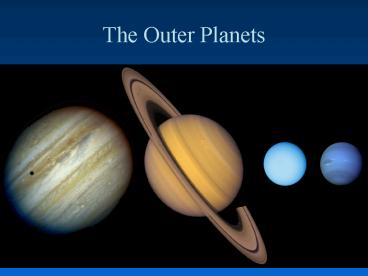The Outer Planets PowerPoint PPT Presentation
1 / 36
Title: The Outer Planets
1
The Outer Planets
2
Distance and density of the Planets
3
Cosmic Abundance of Elements
4
Major Constituents
5
Interiors Big H2 Atmospheres
6
Jupiter vs Saturn
7
(No Transcript)
8
Jupiters Ammonia Clouds Belts Dark
bands Zones Bright bands Great Red Spot White
Ovals
The GRS has lived at least 300 yrs. Ovals have
been seen to survive tens of years
9
Jupiters North Pole
10
- Jupiters clouds result from convection.
- Hot air expands.
- Lighter than the rest of the air, it rises.
- As it rises, it cools and condenses forming
clouds. - When it is cooler than the ambient air, it sinks.
11
Great Red Spot
12
Shoemaker-Levy Impact
13
Jupiters rings
Silicate dust, 10,000 times more transparent than
window glass.
14
Galilean Satellites
15
Jupiters Moons
16
Io
Io
- Images\iovol_vgr.gif
17
Ios surface is almost devoid of craters, for it
is being repaved at a rapid rate.
The glow of warm lava.
A pool of lava (black) covered with sulfur
deposits (orange). This is called Tupan Patera
after the Brazilian thunder god.
Images taken from the Galileo spacecraft.
18
Io is hot
- Lava flows on Io exceed 1500 K in temperature.
Lavas this hot are not sulfur (which would
evaporate immediately). This is hotter than
present lavas on Earth (1300-1450 K). Instead
these lavas are likely ultramafic (rich in Mg and
Fe), similar to the lavas that occurred on early
Earth. - Present hypothesis, a 100 km thick crust floats
on top of a worldwide ocean of magma 800 km deep.
19
What fuels Io?
Each time Ganymede orbits once, Europa orbits
twice, and Io orbits 4 times.
20
Europa
Few craters A terrain containing elements that
were recently dislodged can be seen to neatly fit
together if rotated and translated in position.
21
Ganymede 1km relief
Largest moon 1/2 of the surface is dark and
heavy cratered. The other 1/2 is younger, less
cratered. It appears to be faulted and, at
places, depressed. The low areas appear to be
subsequently flooded. This grooved terrain
indicates recent geological activity.
22
Callisto
Heavily cratered surface with small areas of
spiky landscape. This is hypothesized to be
caused by sublimation (vaporization) of ices on
surface.
Image from the Galileo Spacecraft
23
Saturn
24
Saturns Clouds
25
Saturns North Pole
26
Saturns South Pole
27
Saturns Rings
Ring particles are ice fragments, 1 cm to 10 m
in size, that orbit Saturn. The rings span
70,000 km and are only 20 meters thick! There
are many gaps in the rings as well.
28
Gaps
Embedded moonlets can sweep clear a lane much
larger than its diameter, thus causing gaps like
the Cassini Division.
29
Enceladus
30
Uranus
Absorption of sunlight at red wavelengths by
methane renders the planet blue.
31
Uranus rotation axis
32
Uranus Rings
Rings are made of dark material, unlike ice, and
postulated to be carbonaceous. The rings are
made up of a bunch of narrow rings, separated by
larger gaps.
33
Neptune
Neptune emits more energy from its interior than
does Uranus. This energy drives weather. The
colder temperatures cause methane to condense in
the upper atmosphere these are the clouds that
we see.
34
Triton
Neptunes Largest Moon Triton
On Triton the main component of the atmosphere,
nitrogen, exits in vapor pressure equilibrium.
That is, it exists as an ice on the surface and
as vapor in the atmosphere, in the same way that
water exists as liquid and ice on Earths surface
and as a gas in the atmosphere. The amount of
gas depends on the temperature. Less exists at
cooler temperatures. This is seen on Earth with
the condensation of water at dew point.
Atmosphere 1.6x10-7 bar 38K Nitrogen
35
Neptunes Rings
Narrow rings of varying density
36
Summary
- Giant planets are large gas planets with nearly
solar elemental abundances. - They have small ice-rock cores.
- Their moons are ½ rock and ½ ice.
- Most moons display heavily cratered terrains. Io,
Callisto, Triton and Titan are exceptions. - All jovian planets sport rings of differing
thicknesses, compositions character.

